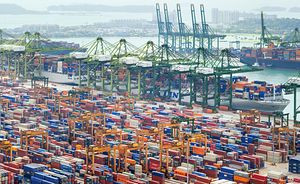Southeast Asia is home to roughly 630 million people, who combined produce a GDP of around 2.4 trillion dollars. It is also a region beset with complicated territorial squabbles, stemming from border to sea-lane disputes. There are many fault lines in this region, and none are more volatile than the South China Sea, a misnomer by some accounts but also a fragile zone of conflict on the precipice of conflict.
As an economic and military juggernaut, China is beginning to realize the challenges it faces in the 21st century. One is energy and the other is territory, hence when 80 percent of Chinese oil imports flow through the Strait of Malacca and into the South China Sea, and when competing nations contest the nine-dashed line, it is clear that China will, short of naval warfare, do everything in its power to establish dominance in a region contested by other naval powers.
Singapore is economically tied to the boom in China, and diplomatically associated with the Association of South East Asian Nations (ASEAN). At present, Singapore is not heeding the maxim si vis pacem para bellum (if you want peace, prepare for war). In short, Singapore’s foreign policy initiatives are based on a simplistic calculation that the cost of war in the region will exceed any gains, which it believes would deter any nation from initiating hostilities. It is a dangerous assumption.
ASEAN has been in existence for a little more than half a century, yet despite its history, it has yet to prove itself to be an influential organization like Mercosur or the African Union. ASEAN’s failure lies in its inability to wrest power from its member states and adjudicate on matters of political or economic importance. Its impotence lies in its inability to become a supranational power with decision-making abilities in the mold of the EU, leaving it a weak, fragmented and feeble institution reflective of the ineffectual treaties and declarations in place.
This poses a geopolitical challenge for weaker countries that have territorial disputes with militarily strong nations in the region. For instance, China has always claimed the nine-dashed line demarcates its territory, and in pushing this claim it prefers to bypass the 1982 United Nations Convention on the Law of the Sea, to negotiate its own terms bilaterally with other contesting parties.
The use of ASEAN as an arbiter in such matters is unwise, as it has always used consensus-based negotiations, as reflected in its charter, declarations and treaties. The 2002 Declaration of Conduct of Parties is structurally and legally insufficient to deal with the territorial issues of the South China Sea, as it cannot legally force states to change their behavior, but is rather based on the consensus and goodwill of the parties.
The Treaty of Amity and Cooperation is a framework intended to deal with regional disputes, but like the DOC, it lacks a mechanism to legally enforce any ruling. This was done specifically so as to not contravene Chapter XVI, Article 103 of the United Nations Charter. The apparent weakness of ASEAN as a mediating body is clear, and with growing regional tensions the bloc could find itself playing a peripheral role on an issue of central importance.
This is where Singapore comes into play. As a country of 5.3 million people, Singapore is not viewed as a military threat in the South or East China Sea. If Singapore could strategically position itself in a central role, it could be expected to mediate with the contesting parties and become a point of contact to facilitate discussions and negotiations between China, Japan, and the U.S. This year’s Shangri-La Dialogue is an apt example of how it can maintain such a unique position.
Singapore is neither a military nor an economic heavyweight, hence it has to calculate the future economic costs should China ever decide to blockade vital sea lanes that account for 33 per cent of world sea-borne trade. The city state should plan ahead by being politically active and invested in this dispute, most usefully by positioning itself as a mediating force with the explicit intention to avert and possibly stave off both possible economic sanctions and naval confrontations in the region.
A financial hub for most of Southeast Asia, Singapore has the financial means to pursue this path. For instance, it could create a Regional Maritime Forum, where important political actors from the principal claimant countries can converge to deliberate on a preliminary treaty that would codify a unified position towards the ongoing disputes.
Second, Singapore should prevail on the signatories to the DOC to replace the pact with a more robust provisional agreement that addresses, say, military activities within exclusive economic zones and perhaps even the regional naval arms race. That, of course, would be very difficult to achieve, but a lengthy negotiation process could be justified by the end goal of regional stability.
Finally, Singapore should call for the establishment of a South China Sea Arbitration Court, with a rules-based procedure based partly on the processes of UNCLOS. China could dismiss Singapore as a gadfly, but it understands better than anyone that having Singapore drive the process would provide it with a better outcome than having its claims contested in The Hague. China knows it can negotiate a better deal within the region with Singapore at its helm. Singapore’s close cultural and linguistic ties to China would also help.
ASEAN has outlived its usefulness and it is in the region’s best interest if a politically neutral entity assumes the mantle of responsibility. Singapore could be a good candidate.
Suhith Sitharthan has worked as a Maritime Security Analyst as well as a Southeast and Northeast Asian research analyst for a top think tank in Australia.

































